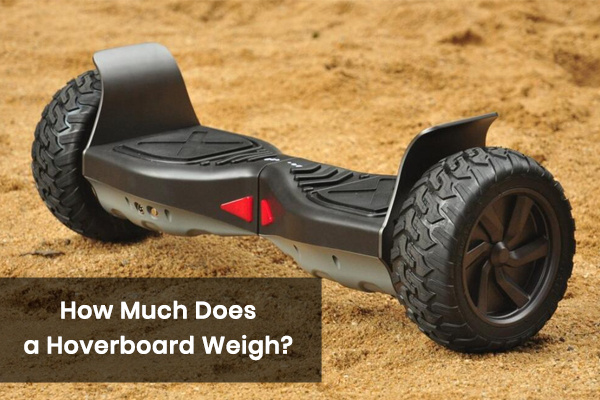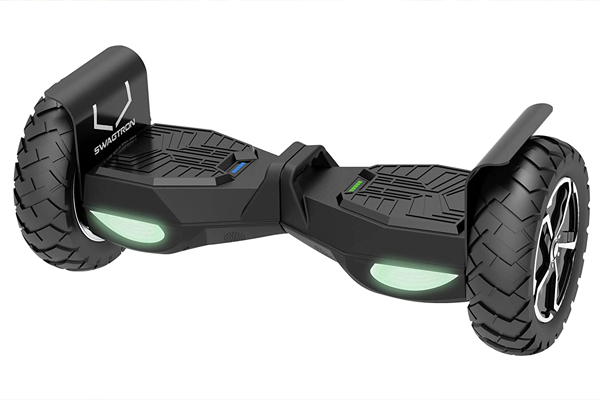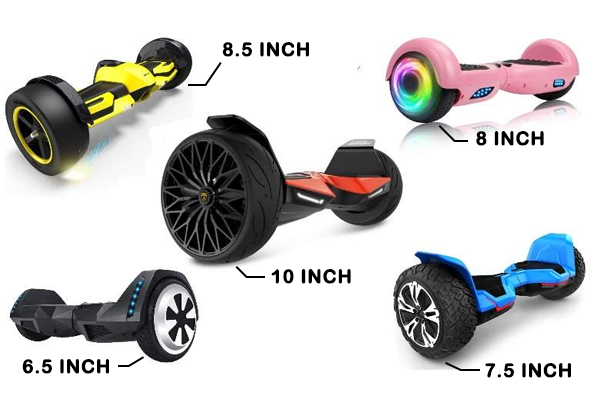Hoverboards are the newest way to travel around for youngsters. A fun way to commute, they aren’t always light and easy to carry. As such, you may find yourself asking “how much does a hoverboard weigh?”

There are many times you might have to carry the hoverboard around. While the weight of a hoverboard plays a significant role in determining the stability of the board, it can get quite tiresome to carry it around. Here are a few essential points about hoverboard weight you have to know.
Why Does the Weight of the Hoverboard Matter?
This must be the first question that comes to your mind. But if you actually ride a hoverboard, you’ll understand how vital its weight is. It affects how you ride and control the board. If the hoverboard is heavier, you will need to put more pressure and force to make it respond to your movements.
This means if you are a light person, buying a heavier board would be a terrible idea. You will need to put in a lot of pressure to control it. Heavy hoverboards are meant for heavier riders as they can carry the rider’s weight and respond ideally.
All hoverboards have a minimum weight limit which is usually around 45 pounds. If a lightweight person rides it, the hoverboard won’t be able to recognize the instructions and respond appropriately. Sometimes, hoverboards won’t even turn on if you are under the minimum weight limit.
Then again, if you are too heavy, the board might have a hard time pulling you or going at the top speed. To have the best experience, you need to pick a hoverboard that is right enough to carry your weight. Most hoverboards can easily handle 220 pounds, but it is better to check as lighter, and longer boards have lower limits at times.
Heavier boards also require a powerful motor and heavier battery to perform better. This can increase the price, but it is not always the case. You should understand that heavy boards do not mean a good battery and motor. They can be heavy and have lousy quality motors.
Weight also determines the quality of the hoverboard material. Sometimes the weight gives you a better grip on different surfaces. You will need a heavier board to maintain balance if you are riding on uneven roads, as lighter boards can easily flip over a stone.
Lighter boards are perfect for pavements. It’s always better to cross-check all the specifications before making a purchase.
Features that Affect Hoverboard Weight
Size of the Hoverboard
The size of the hoverboard determines its weight. The longer and broader it is, the more the weight grows for stability. There are three primary sizes of wheels in the market, 6.5 inches, 8 inches, and 10 inches.
With the smaller wheel size, the hoverboard weighs lesser, making the 6.5 inches the best choice for kids. But unfortunately, the smaller wheel hoverboard limits to areas that are wide, smooth, and flat. For doing hoverboard stunts, go for a 6.5-inch wheel hoverboard, as it gives better balance and control.
The 10-inch wheel hoverboard is better for professionals who want to ride on different kinds of surfaces, including rough terrain. It is the best “transportation” vehicle. It gives a better stability when you want to ride a hoverboard compared to the other sizes. You can always go for an 8-inch wheel hoverboard for daily use.
Another factor you need to consider before deciding the size of the hoverboard is how much you weigh. The more you weigh, the bigger the wheel has to be to maintain the balance.
Build Materials
The materials used to build the board also contribute to its weight. Most hoverboards available in the market are made from plastic, aluminum, magnesium alloys, and metal. Hoverboards made from aluminum and plastic are usually lightweight.
You can find these materials in the 6.5-inch and 8-inch wheel size hoverboards. However, additional features like GPS or Bluetooth speakers can add to the weight of the board. When it comes to magnesium alloys and metal hoverboards, they weigh twice as much as plastic boards.
They have better grip, durability, and stability. It is easier to control and balance metal hoverboards. But adding more accessories to these boards would be a bad idea as they are already heavy. These boards are difficult to carry around, so they are ideal for adults but not kids.
The build material also determines how much force and pressure the rider has to use in order to control and guide the direction of the board. Lighter boards require a simple stir, while metal boards require much more strength. You will have to pick the material based on the rider.
Heavy riders can go for metal and magnesium alloys, while lightweight riders can go for aluminum or plastic ones. If you’re looking for durability and quality, metal, aluminum, and magnesium boards are a better choice. They are perfect for carrying out professional stunts and rides. Note that only a few brands use metal and magnesium alloys for smaller boards.
Battery
Every hoverboard has a lithium-ion battery pack and it can last up to one hour per full charge depending on the model you choose. Do not charge the lithium pack often as it might lose its battery life.
The battery life of the actual ride depends on rider weight, road conditions, and how you maintain the battery. Here are a few suggestions to have better battery life for your hoverboard:
- Check your battery before every ride and make sure it is always lit green.
- Check the weight limit as heavier riders will have shorter trips.
- Also Check for battery damages after a bumpy ride.
Motor
Hoverboards use wheel motors. They are inside the wheels and eliminate all kinds of mechanical power transmission problems. The motor has a maximum power rating of 400 watts. Every hoverboard has two motor wheels allowing the wheels to accelerate and move independently from one another at different speeds.
The electric motors and sensors are the key components of the hoverboards. They determine the longevity and performance of the hoverboard based on the rider’s weight limit. Stronger and higher watt motors are heavier, which means the lightweight hoverboards don’t have powerful motors.
Additional features
You can easily hook add ons to hoverboards. By add ons, we mean extra features that can make your board function better, but your board is still effective without them. It is up to you how you want to equip your self-balancing scooter.
Additional features can make your board heavier. It’s usually a hassle to carry a hoverboard with too many add ons. Having said that, these tech-savvy add-ons make your riding experience more fulfilling and comfortable.
These include inbuilt GPS, speakers that can be connected to your phone, and Bluetooth speakers. The hoverboards can also be hooked with built-in gyroscopes or sensor pads to make them look stylish. Some hoverboards even come with remotes to unlock and lock.
How Heavy is a Hoverboard?
Hoverboards are famously known as self-balancing scooters, which come with two motorized wheels connected on either side of the board. The board comes with articulated pads for riders to place their feet and balance the board.
Just like skateboards, hoverboards also require great practice to lean in and out to control their speed and direction. Hoverboards have been in the market since 2013, but they gained popularity only recently. The vehicle has drastically evolved over the years to meet the expectations of young customers.
It is super trendy to ride around, but you won’t always be riding it. There are places where you would have to carry it around. Adult hoverboards generally weigh around 20 to 30 pounds, depending on the size and brand. Remember, there is a significant difference between hoverboards for kids and those for adults.
Heaviest Hoverboard
The heaviest hoverboard today is the SWAGTRON T6 off-road hoverboard. It has a 10-inch wheel size and auto-balancing ability and a Bluetooth app that supports both iOS and Android devices.
The SWAGTRON T6 weighs around 13.86 kgs and can handle up to 420 pounds or 190 kgs, making it ideal for riders of all shapes and sizes. This model can seamlessly roll over bumps, glide on rough terrains, and incline up to 30 degrees in mud, grass, rain, and gravel.
It has a 12-mile range and can speed up to 12mph. This hoverboard is designed with tubeless tires for all-terrain exploration without any hindrance. It comes with a complete setup of Bluetooth and premium loudspeakers.
In every box of SWAGTRON T6, you will get a skater board unit, one charger, and a complete user manual to understand the device better. It is the heaviest but also the best hoverboard available in the current market.
Minimum Weight Required to Ride a Hoverboard
It is important to consider your weight when you decide to ride a hoverboard. Every hoverboard model has both minimum and maximum weight limits. Most hoverboards have a minimum weight requirement of 44 pounds or 20 kgs.
Hoverboards have sensors that respond to the minimum weight. They detect the direction you lean towards and shift your weight in order to function. These sensors only respond when they feel the minimum weight resting on them.
Riders below the weight limit might encounter a shaky experience. The board starts to vibrate and shake when it can’t read the weight. Usually, hoverboards for kids have lesser minimum weight requirements.
Weight Limits to Ride a Hoverboard
Hoverboards have a minimum requirement of 20 kgs and can handle up to 100 kgs of weight. There are a few exceptions, though, where some brands have a higher weight limit. But most regular hoverboards can easily handle up to 220 pounds.
If the rider exceeds the maximum limit, the board will start performing poorly, and this might damage the board’s components. So, it is essential to check the hoverboard weight limit before riding one. Let’s check out the weight limits assigned by a few popular brands.
- Jetson V12 hoverboard has a weight limit of 220 pounds and is for people above 12 years of age.
- The Polimoda, 8.5-inch hoverboard, has a maximum weight limit of 220 pounds, available in various colors and styles.
- Segway LOOMO hoverboard is a high-end brand that comes with top-notch quality and a maximum weight limit of 220 pounds.
- Gotra SRX hoverboard is a favorite among kids and comes with a maximum limit of 132 pounds.
- Hover-1 Ultra hoverboard comes with a 6.5-inch wheel and a maximum weight limit of 220 pounds.
What Size to Buy?
Now that you know about all the sizes and the factors that determine a hoverboard’s weight, you are probably wondering what size is ideal for you. Well, that entirely depends on how much you weigh and where you plan on riding the board. Read on to know more about this aspect.
What is the Rider’s Weight?
The weight of the rider determines the performance of the hoverboard. If you are a heavy person, it is better to opt for a hoverboard that weighs more to get a better grip and balance. Lighter boards have a weight limit of 100 kgs, whereas heavier boards can handle up to 145 kgs.
Similarly, if you weigh less, it is better to go for lightweight hoverboards. A 6.5-inch wheel is perfect for children, 8.5 inches for lightweight riders, and 10 inches for all adults of different sizes. Remember, you will need more weight and force to control heavier and bigger boards. So pick a board that is comfortable to balance and carry around.
Where is the Rider Riding It?
This is an important question you need to ask yourself before you buy a hoverboard. Will you be riding the board exclusively on smooth pavements, or will you take it for a spin in the mud too? Lighter boards are perfect for smooth rides, while heavier boards are better for bumpy rides.
Heavier boards are also more durable, meaning they can take the hit. On the other hand, lighter boards can easily get damaged if ridden over a rough surface. The best hoverboards would be the heavier ones that ride well on both smooth and rough surfaces.
Final Thoughts
Hoverboards are fun vehicles for traveling over short distances. They make your ride to work or college and back home an exciting one. By now, you have understood that the weight of your hoverboard plays a crucial role in giving you a comfortable ride as well as in keeping you safe.
There are various parameters you need to consider before you choose the right hoverboard. It’s not like you can always ride the board. At times, you will also have to carry it by hand. The good thing is you can use hoverboard carrying bags to avoid the hassle and resume riding them when the time and place are suitable. Well, happy riding then!




Leave a Reply